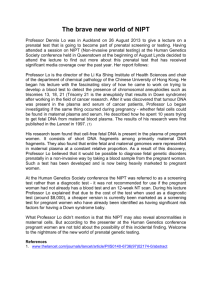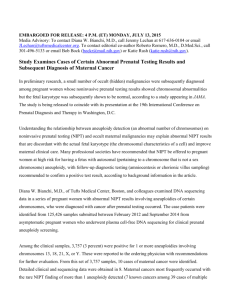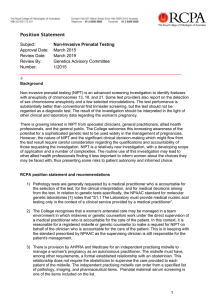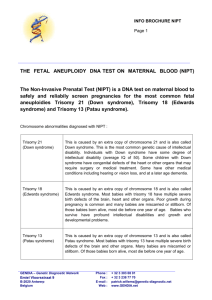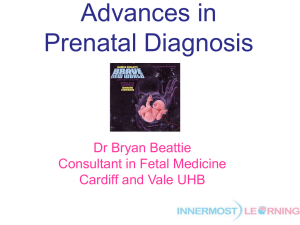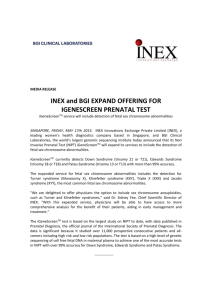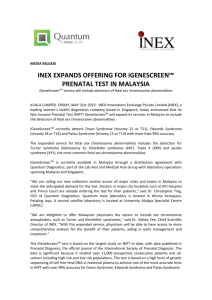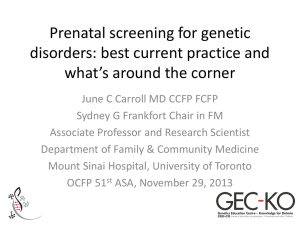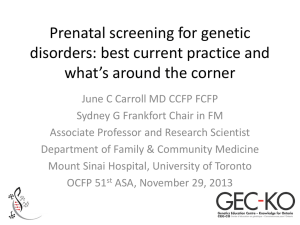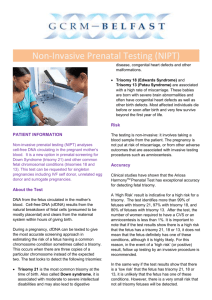Contents:
advertisement
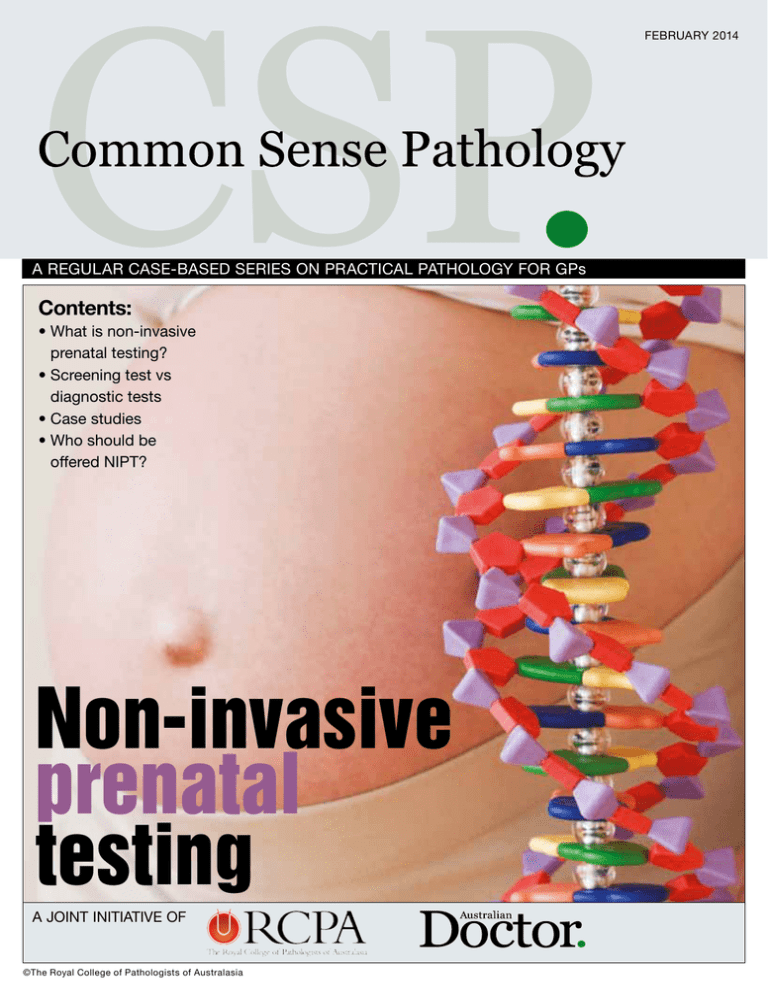
february 2014 A REGULAR CASE-BASED SERIES ON PRACTICAL PATHOLOGY FOR GPs Contents: • What is non-invasive prenatal testing? • Screening test vs diagnostic tests • Case studies • Who should be offered NIPT? Non-invasive prenatal testing A JOINT INITIATIVE OF ©The Royal College of Pathologists of Australasia Authors: Dr Melody Caramins National head, genetics, SDS/Laverty Pathology; conjoint senior lecturer, school of medical sciences, University of NSW. Dr Maya Chopra Clinical geneticist, department of medical genomics, Royal Prince Alfred Hospital, Sydney, NSW. This issue of Common Sense Pathology is a joint initiative of Australian Doctor and the Royal College of Pathologists of Australasia. Common Sense Pathology editor: Dr Steve Flecknoe-Brown Email: sflecknoebrown@gmail.com It is published by Cirrus Media Tower 2, 475 Victoria Ave, Locked Bag 2999 Chatswood DC NSW 2067. Ph: (02) 8484 0888 Fax: (02) 8484 8000 E-mail: mail@australiandoctor.com.au Website: www.australiandoctor.com.au (Inc. in NSW) ACN 000 146 921 ABN 47 000 146 921 ISSN 1039-7116 Australian Doctor Medical editor: Dr Linda Calabresi Email: linda.calabresi@cirrusmedia.com.au © 2014 by the Royal College of Pathologists of Australasia www.rcpa.edu.au CEO Dr Debra Graves Email: debrag@rcpa.edu.au While the views expressed are those of the authors, modified by expert reviewers, they are not necessarily held by the College. Sub-editor: Deborah Smythe Email: deborah.smythe@cirrusmedia.com.au Graphic designer: Edison Bartolome Email: edison.bartolome@cirrusmedia.com.au Production coordinator: Eve Allen Email: eve.allen@cirrusmedia.com.au For an electronic version of this and previous articles, you can visit www.australiandoctor.com.au Click on Clinical and Library, then Common Sense Pathology. You can also visit the Royal College of Pathologists of Australasia’s web site at www.rcpa.edu.au Click on Publications and Forms, then Common Sense Pathology. This publication is supported by financial assistance from the Australian Government Department of Health. 22 Cell-free fetal DNA detected during a pregnancy is DNA considered to be representative of the current fetus. What is non-invasive prenatal testing? Prenatal screening and diagnosis involves testing for conditions in a fetus before it is born, with the aim of detecting causes of birth defects, abnormalities and genetic conditions. Testing procedures can include non-invasive techniques such as serum screening and ultrasonography, or invasive techniques such as amniocentesis and chorionic villus sampling. Genetic testing of fetuses requires genetic material from the fetus. Obtaining tissue of fetal origin for this testing has until recently required invasive techniques: amniotic fluid samples containing fetal cells that are mostly of epithelial origin, or chorionic villus samples that contain mesodermal connective tissue and trophoblastic cells of the placenta. Invasive techniques generally carry greater risks, including, in rare instances, the risk of fetal loss, which is estimated at up to 1%. Non-invasive prenatal testing (NIPT), also known as non-invasive prenatal screening (NIPS) is a new genetic test that uses cell-free circulating fetal DNA in the maternal serum to screen for the more common fetal aneuploidies: trisomy 21 (Down syndrome), trisomy 18 (Edward syndrome), trisomy 13 (Patau syndrome) and monosomy X (Turner syndrome). DNA from the fetus is found circulating in maternal blood. This DNA can be from two sources: intact fetal cells or from circulating cell-free fetal DNA (ccffDNA) from the breakdown of fetal cells that are mostly placental. Whereas intact fetal cells can persist for years after a pregnancy, cell-free DNA clears from the maternal system very quickly and is undetectable in maternal serum within hours after delivery. Thus, cell-free fetal DNA detected during a pregnancy is DNA considered to be representative of the current fetus. The majority of cell-free DNA circulating in maternal blood is maternal in origin; only about 10-15% is of fetal origin, although this fetal fraction can be detected and measured. The fetal fraction is influenced by a number of factors, with the most significant of these being maternal weight. Increasing maternal weight is associated with decreasing fetal fraction of DNA. In NIPT, the cell-free chromosome fragments are measured and quantitative differences in the number of DNA fragments from different chromosomes are used to distinguish pregnancies with aneuploidies from those that are not affected. For example, fetuses with trisomy 21 (Down syndrome) will have a measurable and statistically significant increase in the number of chromosome 21 DNA fragments. Owing to increasing patient access to healthcare information as well as advertising, many consultations regarding NIPT are likely to be initiated by pregnant women themselves. It is therefore important that GPs, who are likely to be the first point of contact for antenatal healthcare, are able to provide appropriate counselling and guidance to their patients in order to inform appropriate decision-making. They should be able to provide accurate information regarding these tests, their appropriateness and limitations, as well as specialist referral and follow-up. 3 5 A Screening tests vs diagnostic tests: what is the difference? There are several key differences between screening and diagnostic tests, as summarised in table 1 (below). The chief differences are the population tested and thus the expected incidence of disease, and the sensitivity/specificity of the test. Screening usually involves testing an asymptomatic patient population with low incidence, whereas diagnostic testing involves testing patients who have exhibited symptoms and would thus be expected to have a higher incidence of a condition. Screening tests are also general- ly weighted towards higher sensitivity, in order to avoid missing potential disease. Therefore, some false-positive results are to be expected. NIPT shares features of both screening and diagnostic tests, although it is currently more appropriately considered to be a screening test. The sensitivity and specificity for NIPT has been most extensively evaluated for detecting trisomy 21 in high-risk women — in this clinical setting, the sensitivity of NIPT is 99.5% and the specificity is 99.8%.1 Sensitivities reported for trisomy 13 and 18 have been more variable, with reports of up to 100% sensitivity and 99.9% specificity; however, data from Table 1 – Comparison of settings and criteria for screening and diagnostic testing 24 Screening test Diagnostic test Purpose To detect potential disease indicators To establish presence/absence of disease Sensitivity and specificity Often chosen towards high sensitivity not to miss potential disease; may result in some false positives Chosen towards high specificity (true negatives) Patient population Large numbers of asymptomatic, but potentially at-risk individuals Symptomatic individuals to establish diagnosis, or asymptomatic individuals with a positive screening test Test method Simple and acceptable to patients May be invasive and/or expensive. Accuracy and precision more important than patient acceptability Cost Generally cheap, given large numbers of people will need to be screened to identify a small number of potential cases Higher costs often justified as necessary to establish a diagnosis She has heard about ‘the new accurate blood test for Down syndrome’ and is keen for more information. these less-frequent aneuploidies will require confirmation in larger abnormal cohorts.2 More recent publications have begun to evaluate the use of NIPT in pregnancies of low to average risk, although more data are required for definitive recommendations in this clinical group.3,4 Currently, RANZCOG states, “NIPT should not be routinely offered to low-risk women or in multiple pregnancy as it has not been sufficiently evaluated in these groups. Its use as a primary screening modality in the general pregnant population requires more clinical and economic evaluation. This situation may change in the future with the results from ongoing studies and the expected decline in the price of NIPT.”5 Although several models for incorporating NIPT in the current prenatal screening model have been suggested, a consensus on this has not yet been reached. One model proposed by Hui et al. (contingent screening) recognises the benefits of combined first trimester screening (cFTS) and incorporates NIPT as a second-tier screen for women with an intermediate cFTS result (1/10-1/1000).1 Non-invasive prenatal testing can be performed from 10 weeks’ gestation and results are generally available between 10-15 days. CASE 1 Mai is 32 years old and six weeks pregnant. She has heard about “the new accurate blood test for Down syndrome” and is keen for more information. She would like to have the blood test as soon as possible and asks whether she really needs a first trimester screen. What key points would you explain to Mai? • cFTS (nuchal translucency plus serum BHCG and PAPP-A) is an effective screening tool for the common chromosome aneuploidies, performed at 11.513.5 weeks’ gestation. The detection rate for Down syndrome is 90% and there is a false-positive rate of 5%.6 cFTS has several other benefits, including the detection of multiple pregnancy. • Women with a high-risk cFTS result (risk > 1/300) may consider definitive testing with a fetal karyotype. This requires an invasive procedure (chorionic villus sampling or amniocentesis), with a small risk of miscarriage. Women with a lower risk result who would prefer to be reassured with a definitive test may also request invasive testing. • NIPT is a new, highly sensitive screening tool for Down syndrome (and other chromosome aneuploidies), which can be performed as early as 10 weeks. The test has a low false-positive rate (<1%). • NIPT incurs a cost to the patient of $650-$1250. Testing is often patient initiated. The utility of the test in low-risk women has been questioned.1 Mai is concerned about the cost of NIPT. She opts to proceed with a Outcome cFTS and will then make a decision about NIPT, depending on the result. Her first trimester screen result yields a 1/2456 risk for Down syndrome. She is reassured and decides not to proceed with NIPT. 5 A CASE 2 Andrea is 37 years old and 12 weeks pregnant. This is her first pregnancy and was conceived by IVF after multiple unsuccessful cycles. She presents with the results of her combined first trimester screen, which shows a 1 in 30 risk of trisomy 21. She has concerns about the risk of miscarriage with an invasive procedure. She asks about the advantages and disadvantages of having NIPT instead. She is booked to see her obstetrician next week. What are the advantages and disadvantages of NIPT in this case? Advantages of NIPT: • No risk to the pregnancy. • A highly sensitive screening test for Down syndrome, which means that a normal result would be very reassuring in this setting. Disadvantages of NIPT: • Analysis is restricted to chromosomes 13, 18, 21, (and in some cases X and Y). Atypical chromosome abnormalities (ie, those that would be missed on NIPT) account for 30% of all abnormal karyotypes.7 • A small proportion of women have an indeterminate NIPT result, usually on the basis of a low fetal fraction. • The high cost incurred by the patient. • A positive result requires confirmation by invasive testing before action is taken. Table 2 - Comparison of some performance criteria for the commonly used prenatal tests 26 NIPT cFTS Chorionic villus sampling/ amniocentesis Risk to pregnancy No No Yes, 0.5-1% Detection rate for Down syndrome High (sensitivity, or true positive ≥99.5% or higher) Moderately high Diagnostic test (≥99.9%) False-positive rate Low (specificity, or true negative Moderate ≥99.8%) Ability to detect other chromosomal abnormalities Currently 13, 18, 21 (+/- X and Y). These account for ~70% of the major chromosomal abnormalities Targeted to screen for trisomy 13,18, 21 Diagnostic test (≥99.9%) Yes • Plain karyotype: all chromosomes to a resolution visible on microscopy (5-10 million DNA base pairs • Chromosome microarray: all chromosomes to a relatively high submicroscopic resolution (generally less than 250,000 DNA base pairs) Chromosome microarray is now established as the primary tool in the evaluation of intellectual disability or structural malformations. After much deliberation, in consultation with her obstetrician, Andrea decides to Outcome have NIPT and the result is consistent with trisomy 21. She then proceeds with chorionic villus sampling and trisomy 21 is confirmed. CASE 3 Karen is a 35-year-old woman in shared antenatal care. She is 19 weeks into an unplanned pregnancy. At 15 weeks she had NIPT (arranged through her booking hospital in consultation with a genetics counsellor and fetal medicine unit) because she missed her first trimester screen. Her NIPT results were normal. Her 19-week morphology scan shows intrauterine growth retardation, a ventricular septal defect and possible coarctation of the aorta. In consultation with the fetal medicine specialist, Karen has an amniocentesis for a chromosome microarray. The result shows a 2.5Mb (2.5 million DNA base pairs) microdeletion of 22q11. She is referred to a clinical geneticist. She is advised that her baby has VCFS or velocardiofacial syndrome, a microdeletion syndrome associated with intellectual disability, conotruncal cardiac anomalies, immunodeficiency and palatal anomalies. What is a prenatal microarray? Chromosome microarray, or molecular karyotyping, is now established as the primary tool in the evaluation of intellectual disability or structural malformations in infants and children. The technique allows for the detection of small deletions and duplications at a much higher resolution than standard cytogenetic analysis (karyotype). Microarray in the prenatal setting may be considered on a case-by-case basis, but its use is likely to become more widespread. Some clinical guidelines for Australian specialists are currently in preparation. In some centres, it is the primary modality for chromosome analysis regardless of the indication for invasive testing. In high-risk pregnancies, the additional yield of microarray is 6%.8 The test should be offered in the setting of high nuchal translucency measurement or structural malformations on ultrasound. Consent and pre- and post-test counselling is essential, particularly with regard to the possibility of identifying a variation of uncertain significance. Submicroscopic deletions and duplications are not tested or reported in current NIPT methods, but this may be possible in the future. Because of the high technical and interpretive complexity of prenatal chromosomal microarray, along with the serious potential clinical ramifications and high cost, only specialist physicians should request this test. These physicians have the appropriate training and skills to provide counselling and explain results, which would need to be done in close consultation with a specialist genetic pathology laboratory that is skilled in conducting such tests. Summary: who should be offered NIPT? There are currently no Australian clinical guidelines that define the place of NIPT in screening and diagnosis for pregnant women, therefore different approaches have been adopted in different practices. The routine first trimester screen in Australia provides a risk assessment that combines risk based on age, biochemical and ultrasound findings (cFTS). In the US, a second trimester biochemical-only screen is in place; in this setting, the American College of Obstetrics and Gynecology advises the use of NIPT in ‘high risk’ pregnancies only. 7 5 A NIPT is offered as a secondtier screen following a combined first trimester screen. There are a number of implementation models proposed in a recent review by Hui and Hyett in the Australian setting.1 The adjunct model has become relatively common practice in some obstetrics and gynaecology practices in Australia recently. Under this model, NIPT is offered as a second-tier screen following a combined first trimester screen, using the following guidelines: 1.Low risk (risk less than 1 in 300 on cFTS): Suggest no further testing. The chance of having a baby with Down syndrome after a result in this range is very low. 2.Increased risk (risk greater than 1 in 300 on cFTS): Offer chorionic villus sampling/amniocentesis or NIPT. This is the risk bracket where many false-positive results of the first trimester screening test occur. Although invasive testing can provide certainty about chromosome abnormalities, it also has a risk, albeit low, of causing miscarriage. Patients who want to avoid this risk may choose to opt for NIPT. If the NIPT result is ‘abnormal’, then invasive prenatal testing would be recommended to confirm the diagnosis. As previously mentioned, other models of practice incor- References 1. Hui L, Hyett J. Noninvasive prenatal testing for trisomy 21: challenges for implementation in Australia. Australia and New Zealand Journal of Obstetrics and Gynaecology 2013; 53:416-24. 2. Jiang F, et al. Noninvasive Fetal Trisomy (NIFTY) test: an advanced noninvasive prenatal diagnosis methodology for fetal autosomal and sex chromosomal aneuploidies. BMC Medical Genomics 2012; 5:57. 3. Fairbrother G, et al. Clinical experience of noninvasive prenatal testing with cell-free DNA for fetal trisomies 21, 18, and 13, in a general screening population. Prenatal Diagnosis 2013; 33:580-83. 4. Nicolaides KH, et al. First-trimester contingent screening for trisomies 21, 18 and 13 by biomarkers and maternal blood cell-free DNA testing. 28 poration also exist, which include further subdivision of risk categories from cFTS to very low (aneuploidy risk <1/1000 on cFTS), low (1/300-1/1000), high (>1/300), or very high (>1/10) with recommendations in each category. The incorporation of non-invasive prenatal testing into the current model Conclusion for aneuploidy screening offers some further advantages, as well as additional choices, to women in the antenatal period. It does not currently attract a Medicare rebate and therefore costs are generally borne by patients. It has excellent performance characteristics for Down syndrome detection, although it is not currently recommended as a stand-alone diagnostic test. It is recommended that testing be carried out in consultation with specialist obstetricians, and if necessary, clinical genetics services who can appropriately direct reflexive and additional testing and are skilled in the provision of counselling. Fetal Diagnosis and Therapy 2013; online. 5. RANZCOG. College Communique — Noninvasive Prenatal Testing for Fetal Aneuploidy, 23 August 2013. [www.ranzcog.edu.au/news/1152-noninvasiveprenatal-testing-for-fetal-aneuploidy.html] 6. O’Leary P, et al. Regional variations in prenatal screening across Australia: stepping towards a national policy framework. Australia and New Zealand Journal of Obstetrics and Gynaecology 2006; 46:427-32. 7. Alamillo CM, et al. Nearly a third of abnormalities found after first-trimester screening are different than expected: 10-year experience from a single center. Prenatal Diagnosis 2013; 33:251-56. 8. Wapner RJ, et al. Chromosmal microarray versus karyotyping for prenatal diagnosis. New England Journal of Medicine 2012; 367; 2175-84.
